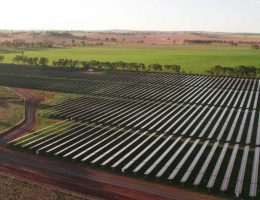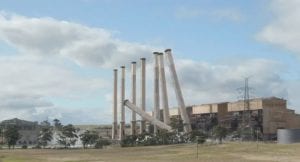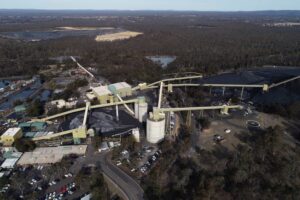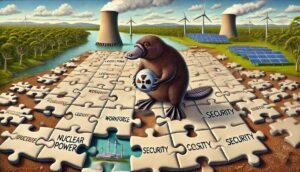It’s a long running tactic, held close by successive conservative Australian governments: if you plan to do nothing on climate change, at least make it look like you’re doing something.
This usually entails focusing heavily on the least effective, most far-in-the-future (and the most palatable for the fossil fuel industry) climate options, running hard with those, and ignoring cheap, effective, and immediate options. Go horrifically slow, and seek credit for the fact that you’re going at all, is a simple summary.
It traces as far back as John Howard’s toothless emissions trading scheme, was reborn in both ‘Direct Action’ and the ‘Emissions Reductions Fund’, was paused briefly as Tony Abbott ditched the pretence and attacked climate action too obviously, and has been most recently re-de-energised through the government’s replacement for a federal zero emissions target and increases to the Paris target: a list of potential machines named the ‘technology roadmap‘.
Most recently, it was revealed at RenewEconomy that a draft discussion document preceding the roadmap, set to be released in coming months, was comprised mostly of conjecture, with extremely opaque assumptions underpinning a range of baffling bubble charts. It’s deeply unsurprising; the entire project is designed to meet the requirements of sounding vaguely like it’s associated with climate change while ensuring any actual emissions reductions are both unlikely and non-compulsory.
As an endgame for COVID19 slowly materialises over the end of this year and early into next, public attention on climate change will return to those who are botching responsibility for the climate crisis despite knowing precisely what to do to fix it.
A new report from the International Energy Agency (IEA), ‘Energy Technology Perspectives 2020’ (ETP) can be seen as a bigger and wider-ranging cousin of Australia’s technology roadmap project. What it highlights is that a narrow approach, and an approach that avoids any style of government intervention or target-setting, is a recipe for disaster – a disaster Australia’s leaders are currently brazenly encouraging.
The acceleration of electrification needs to accelerate
If we tackled the power sector without putting mind to its expansion, it would only account for one third of the task to get to net zero emissions globally. But if it’s made to subsume other, currently non-electrified sectors – such as transport and buildings – cheap renewables could become the global engines of transformation.
“Spreading the use of electricity into more parts of the economy is the single largest contributor to reaching net-zero emissions”, says the ETP. It’s true – for the IEA’s ‘Sustainable Development Scenario’ (SDS), in which we reach net zero emissions by 2070, the bright blue strip is the largest, followed closely by growth in renewables:
 Electrification involves the increased use of things like electric vehicles, to reduce use of combustion engine vehicles, or heating homes using devices like heat pumps, which use electricity instead of the fossil fuelled heating systems common in Australia. Should we check in on the latest electric vehicle policies, from Australia’s Energy and Emissions Reduction Minister, Angus Taylor?
Electrification involves the increased use of things like electric vehicles, to reduce use of combustion engine vehicles, or heating homes using devices like heat pumps, which use electricity instead of the fossil fuelled heating systems common in Australia. Should we check in on the latest electric vehicle policies, from Australia’s Energy and Emissions Reduction Minister, Angus Taylor?
— Angus Taylor MP (@AngusTaylorMP) April 6, 2019
That this type of thing is a deep and permanent embarrassment for Australians is well-earned. Not only will the upcoming technology roadmap shun the challenges of deep electrification that will, elsewhere in the world, comprise the majority of climate action, it will likely be infused with the explicitly anti-technological fervour that has become the norm in the government once the juvenile, meme-driven standard was set during the 2019 federal election.
Falling gas usage is a best-case scenario for climate
In the report, the IEA details how gas will change in its SDS (the less bad outcome), the scenario in which we reach zero emissions by 2070. This is compared to the ‘stated policies scenario’ (STEPS, the worse outcome), in which we toddle along, business as usual, and badly overshoot our emissions targets with dire consequences for humanity. The results are clear: less gas leads to better outcomes – obviously, because gas is a fossil fuel and if we displace it with alternatives, there are fewer emissions:  In a good emission scenario, there is less gas. In a bad emission scenario, there is more gas. It doesn’t get simpler than that, but somehow, Taylor and his department have been attempting to frame gas as leading to climate resolution through a wide range of rhetorical and mathematical tricks, culminating in this year’s “gas-fired recovery” campaign, in which the fossil fuel is billed as the centrepiece to recovering from a pandemic.
In a good emission scenario, there is less gas. In a bad emission scenario, there is more gas. It doesn’t get simpler than that, but somehow, Taylor and his department have been attempting to frame gas as leading to climate resolution through a wide range of rhetorical and mathematical tricks, culminating in this year’s “gas-fired recovery” campaign, in which the fossil fuel is billed as the centrepiece to recovering from a pandemic.
Figuring out how to reduce coal, gas and oil usage requires long term planning, not just shopping lists of technologies. The IEA goes to great lengths to highlight this in the latter end of their ETP. “Most energy producing and consuming assets have long lifetimes and require largescale investment.
This makes long-term planning very important in the energy sector”. They list several regions with law or policy emissions targets, including several within Australia. But Australia as a country is conspicuously absent – another embarrassment, but one that is extremely significant and that has dire consequences for managing the energy transition. 
The IEA’s ETP 2020 certainly highlights the need for investment in ‘hard to decarbonise’ sectors. But the nuances of the 400 page report detail the importance of large-scale change driven by non-fossil technologies and fuels, like wind, solar, EVs, hydrogen and bioenergy, as doing the bulk of the hard lifting.
It is mostly unsurprising, but most importantly, it is deeply embarrassing for one of the world’s most significant fossil-fuel exporting nations, which has spent many years now openly shunning that heavy lifting, to now face up to the global consensus on climate action. Playing around the edges in an effort to fake climate commitments is more than immoral now. It’s embarrassing, and once the pandemic passes and COP26 rolls up, Australia may be far more embarrassed than ever before.










